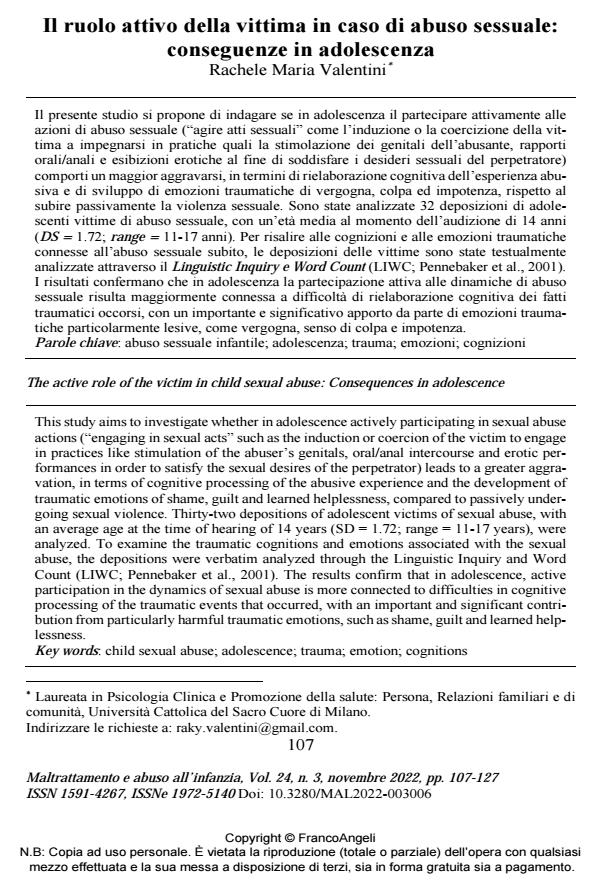Il ruolo attivo della vittima in caso di abuso sessuale: conseguenze in adolescenza
Titolo Rivista MALTRATTAMENTO E ABUSO ALL’INFANZIA
Autori/Curatori Rachele Maria Valentini
Anno di pubblicazione 2023 Fascicolo 2022/3
Lingua Italiano Numero pagine 21 P. 107-127 Dimensione file 206 KB
DOI 10.3280/MAL2022-003006
Il DOI è il codice a barre della proprietà intellettuale: per saperne di più
clicca qui
Qui sotto puoi vedere in anteprima la prima pagina di questo articolo.
Se questo articolo ti interessa, lo puoi acquistare (e scaricare in formato pdf) seguendo le facili indicazioni per acquistare il download credit. Acquista Download Credits per scaricare questo Articolo in formato PDF

FrancoAngeli è membro della Publishers International Linking Association, Inc (PILA)associazione indipendente e non profit per facilitare (attraverso i servizi tecnologici implementati da CrossRef.org) l’accesso degli studiosi ai contenuti digitali nelle pubblicazioni professionali e scientifiche
Il presente studio si propone di indagare se in adolescenza il partecipare attivamente alle azioni di abuso sessuale (“agire atti sessuali” come l’induzione o la coercizione della vittima a impegnarsi in pratiche quali la stimolazione dei genitali dell’abusante, rapporti orali/anali e esibizioni erotiche al fine di soddisfare i desideri sessuali del perpetratore) comporti un maggior aggravarsi, in termini di rielaborazione cognitiva dell’esperienza abusiva e di sviluppo di emozioni traumatiche di vergogna, colpa ed impotenza, rispetto al subire passivamente la violenza sessuale. Sono state analizzate 32 deposizioni di adolescenti vittime di abuso sessuale, con un’età media al momento dell’audizione di 14 anni (DS = 1.72; range = 11-17 anni). Per risalire alle cognizioni e alle emozioni traumatiche connesse all’abuso sessuale subito, le deposizioni delle vittime sono state testualmente analizzate attraverso il Linguistic Inquiry e Word Count (LIWC; Pennebaker et al., 2001). I risultati confermano che in adolescenza la partecipazione attiva alle dinamiche di abuso sessuale risulta maggiormente connessa a difficoltà di rielaborazione cognitiva dei fatti traumatici occorsi, con un importante e significativo apporto da parte di emozioni traumatiche particolarmente lesive, come vergogna, senso di colpa e impotenza.
Parole chiave:abuso sessuale infantile; adolescenza; trauma; emozioni; cognizioni
Rachele Maria Valentini, Il ruolo attivo della vittima in caso di abuso sessuale: conseguenze in adolescenza in "MALTRATTAMENTO E ABUSO ALL’INFANZIA" 3/2022, pp 107-127, DOI: 10.3280/MAL2022-003006